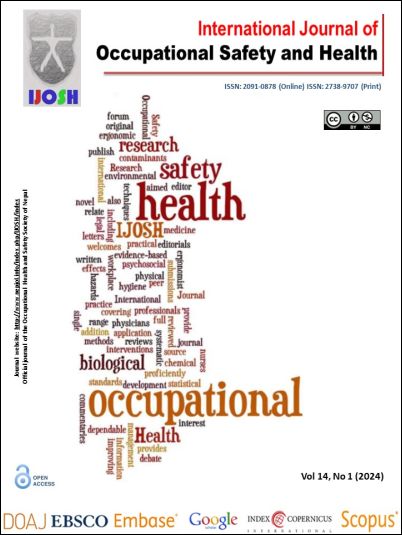Prevalence of work-related musculoskeletal disorders and ergonomic risk assessment among production workers of pig slaughterhouse in the town municipality of Ang Thong, Thailand
DOI:
https://doi.org/10.3126/ijosh.v14i1.57401Keywords:
prevalence, Rapid Entire Body Assessment, slaughterhouse, work-related musculoskeletal disordersAbstract
Introduction: Work-related musculoskeletal disorders (WMSDs) are a significant health concern among workers, especially in the meat processing industry. Their impacts have been well documented and reported on numerous occasions. The study aimed to determine the prevalence of WMSDs and the ergonomic assessment of exposure to their risk factors.
Methods: This cross-sectional study was conducted in a pig slaughterhouse in the town municipality of Ang Thong, Thailand. Data were collected from April to July 2021 from 108 participants who answered a questionnaire. The descriptive questionnaire for WMSDs was adapted from the Standardized Nordic Questionnaire in Thai and the Bureau of Occupational and Environmental Diseases, Department of Disease Control of Thailand. Ten individuals received an ergonomic assessment of their exposure to risk factors using the Rapid Entire Body Assessment (REBA) method.
Results: According to the study, 94.4% of participants working in pig slaughterhouse production reported experiencing the prevalence of WMSDs in the last seven days. Additionally, 93.5% of workers reported experiencing the prevalence of these disorders within the past 12 months. It has been observed that 29.6% of participants experience higher pain levels in their hands, while 25.9% experience it in their wrists, respectively. Based on the results of an ergonomic risk assessment using the REBA method, the half-cutting operator position presents a moderate level of risk.
Conclusion: The study revealed that most of the workers at the pig slaughterhouse had to use their hands and arms to apply repeated pressure consistently. The occurrence rates of WMSDs within the last seven days and 12 months were highest in the hands or wrists, followed by the upper arms and shoulders. Therefore, it is crucial to implement ergonomic measures to minimize the risk factors for WMSDs among production workers in pig slaughterhouses.
Downloads
Downloads
Published
How to Cite
Issue
Section
License
Copyright (c) 2023 Rittikorn Sompan, Orawan Keeratisiroj, Piraya Aungudornpukdee, Reduerat Mahaboonpeeti

This work is licensed under a Creative Commons Attribution-NonCommercial 4.0 International License.
This license enables reusers to distribute, remix, adapt, and build upon the material in any medium or format for noncommercial purposes only, and only so long as attribution is given to the creator.





